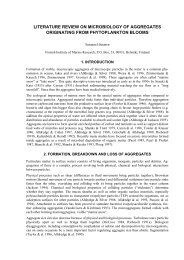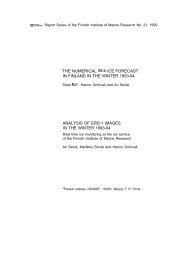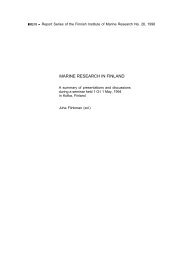BALTIC SEA ENVIRONMENT PROCEEDINGS No. 80
BALTIC SEA ENVIRONMENT PROCEEDINGS No. 80
BALTIC SEA ENVIRONMENT PROCEEDINGS No. 80
- No tags were found...
You also want an ePaper? Increase the reach of your titles
YUMPU automatically turns print PDFs into web optimized ePapers that Google loves.
GENERAL ERRORS INVOLVED IN SEDIMENT SAMPLINGThe principal requirement for a perfect sediment sample is that it must be undisturbed. This means thatthe unconsolidated surface layers should remain undisturbed and unmixed and if conventional coringtubes or vessels are used, the covering water on top of the sediment should be as clear as it is in situ. Italso means that all the lower layers must be unmixed and at exactly the same depth in the sample as theyare in situ.The main errors involved in sediment sampling are (Fig. 1):(1) LOSS OF soft, watery and unconsolidated SURFACE SEDIMENTS as a result of- SCAVENGING (BLOW-AWAY) caused by the pressure wave ("shock wave" or "bow wave") builtup in front of the descending sampler;(2) MIXING and REDISTRIBUTION OF sampled SEDIMENT LAYERS as a result of the pressurewave, resuspension and other external or internal factors;(3) CORE SHORTENING = the difference between the depth of the corer’s penetration into thesediment and the interior length of the core, i.e. the core is compressed;(4) SMEARING = downflow of particles from the top layers to deeper layers along the core wallsduring coring and/or slicing;(5) EDGE EFFECT = loss of material from the margins of the sediment core, which means that thesurface area of the core is smaller than the orifice of the corer;(6) BRIMMING = filling of the sampler up to the brim;(7) TILTING of the sampling device at the bottom;(8) LOSS OF ENCLOSED MATERIAL as a result of brimming or tilting;(9) INGRESS OF SEDIMENT FROM THE OUTSIDE into the sample as a result of brimming,tilting or resuspension.The most important characteristic of a sampling device is that it must allow an unhindered flow of waterthrough the corer during descent and the penetration into the sediment. Otherwise, the hydraulic shockwave (bow wave) created in front of the orifice may laterally disperse the easily resuspended surfacesediments before the corer reaches the sediment surface (Blomqvist, 1992). In all respects, goodhydrodynamic design of the corer is of great importance in avoiding the consequences of the shock wave.Many corers tend to tilt at the bottom when the attachment wire slackens. The taller the sampling device,the greater the risk of tilting; a high centre of gravity further increases the risk. Loss of the enclosedmaterial and ingress of sediment from the outside are not the only consequences of tilting. Inside, tiltingmay cause accumulation of the surface sediment on one side and a wedge-shaped gap in the sediment onthe opposite side between the bulk sediment and the wall of the corer (Blomqvist, 1992). This gap isoften filled by material from the surface layer, which causes errors in the slicing as well as a slopingsurface in the sample itself.The risk of core shortening when small-diameter gravity corers are used has been widely discussed (e.g.Blomqvist, 1985). Nevissi et al. (1989) stated that the shortening of sediment cores is an artefact ofcoring processes and occurs to some extent in almost any coring device. It is related not only to the typeof coring device but also the sediment properties and the velocity of corer penetration into the sediment.As the core barrels are inserted into the sediment, friction along the barrel walls causes core shortening(Jahnke and Knight, 1997). Morton and White (1997) reported that core shortening can result fromseveral different processes, including physical compaction, sediment thinning and sediment bypassingduring sampling. The amount of core shortening as a function of the corer’s penetration depth is affectedby core diameter and penetration velocity (Blomqvist, 1992). In general, there is less core shortening incorers with a large diameter and when the penetration is slow. In extremely soft surface sediments withvery high water content, core shortening is usually low.











